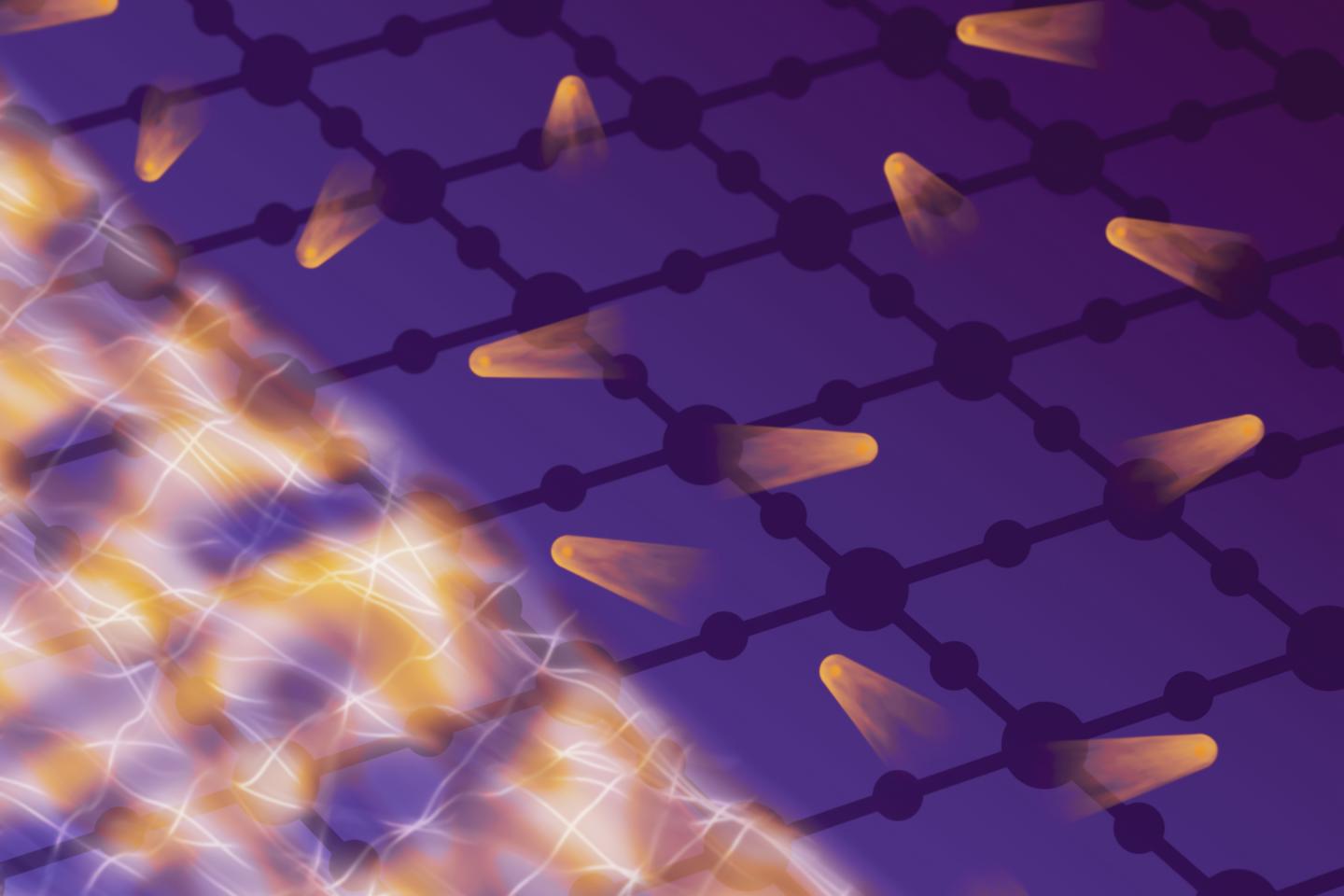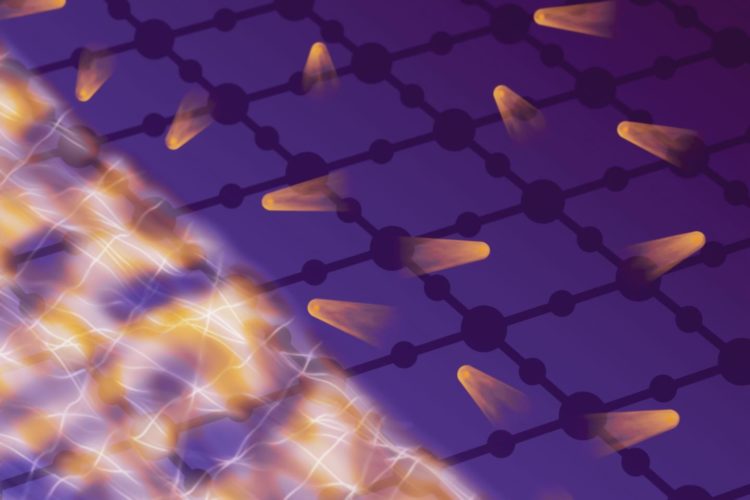It reveals an abrupt transition in cuprates where particles give up their individuality; the results flip a popular theory on its head

Credit: (Greg Stewart/SLAC National Accelerator Laboratory)
Every character has a back story, and so do high-temperature superconductors, which conduct electricity with no loss at much higher temperatures than scientists once thought possible. To figure out how they work, researchers need to understand their “normal” state, which gives rise to superconductivity when the material is cooled below a critical transition temperature and the density of free-flowing electrons is tweaked in a process known as “doping.”
Even in their normal state, these materials are pretty peculiar. Now, an experiment at the Department of Energy’s SLAC National Accelerator Laboratory has probed the normal state more accurately than ever before, and discovered an abrupt shift in the behavior of electrons in which they suddenly give up their individuality and behave like an electron soup.
A research team from SLAC and Stanford University described the results in Science.
“The abnormality of this normal state is suspected to be the reason why these superconductors are such good superconductors,” says Dirk Van Der Marel, a researcher at the University of Geneva who was not involved in the study.
“This study has essentially overthrown a very popular and hotly debated theory, called quantum critical point theory, that is thought to underlie superconductivity not only in this material, but in other materials as well. This is a disruptive finding, but it’s a step forward, because it frees our minds to explore other ideas.”
Exploring a well-known cuprate
The study was carried out on a compound called Bi2212, one of the most thoroughly studied high-temperature superconductors. As a copper oxide, or cuprate, it’s part of a family of compounds where high-temperature superconductivity was first discovered more than 30 years ago.
Scientists across the world have been working ever since to understand how these materials function, with a goal of finding superconductors that operate at close to room temperature for applications like perfectly efficient power lines.
One of the most important tools for studying these materials is angle-resolved photoemission spectroscopy (ARPES). It uses light – in this case a beam of ultraviolet light from SLAC’s Stanford Synchrotron Radiation Lightsource (SSRL) – to kick electrons out of the material and measure their energy and momentum. This reveals how the electrons inside the material behave, which in turn determines its properties.
In superconductivity, for instance, electrons overcome their mutual repulsion and form a sort of collective soup in which they can pair up and flow past obstacles without losing any of their energy.
Frustrated electrons
Earlier generations of so-called conventional superconductors, which operate only at extremely low temperatures, are conventional metals in their normal state, where their electrons act independently, as they do in most materials.
But in cuprates the picture is very different. Even in their normal, non-superconducting state, electrons seem to recognize each other and act collectively, as if they were dragging each other around, in what’s known as “strange metal” and even “incoherent strange metal” behavior.
“In a way you can think about these electrons as being frustrated,” said Zhi-Xun Shen, a professor at Stanford and SLAC and investigator with the Stanford Institute for Materials and Energy Sciences (SIMES) at SLAC who led the study. “In other words, the electrons have sort of lost their individual identity and become part of the soup. This is a really interesting, challenging state to describe in theoretical ways.”
It’s been hard to explore these fascinating normal states at the warm temperatures where they occur, said Su-Di Chen, a Stanford graduate student who performed the experiments with SLAC postdoctoral researcher Yu He, Stanford postdoc Jun-Feng He and SSRL scientist Makoto Hashimoto. The theoretical part of the study at SLAC was led by SIMES Director Thomas Devereaux.
A surprisingly sharp boundary
In ARPES experiments, samples are usually placed in a cold environment inside a vacuum chamber to minimize contamination of the surface, Chen said: “But even if you put them in an ultra-high vacuum, residual gas molecules can still attach to the sample surface and affect the quality of our measurement. This problem gets worse when you warm the environment around the sample to the temperatures where the normal states exist.”
To get around this, Hashimoto said, the team found a way to warm the sample, which is about the size of the tip of a ballpoint pen, by warming just the part of the setup that holds it while keeping everything else cold. This allowed them to examine the electrons’ behavior across a range of temperatures and doping levels.
“What we saw was that as you increase the level of doping, there’s a very sharp boundary,” Hashimoto said. “On one side the electrons are jammed, or frustrated. Then, as more electrons are added, they suddenly start moving smoothly, an indication that the material is now a conventional metal. This transition was known to happen, but the fact that it was so sharp was a real surprise.”
A challenge for theory
The results pose a challenge for theorists who still struggle to explain how high-temperature superconductors work, said paper co-author Jan Zaanen, a theoretical physicist at the University of Leiden in The Netherlands.
Current theory predicts that because changes in the nature of Bi2212 are gradual at very low, superconducting temperatures, they should also be gradual at the higher temperatures where the material is in a normal state, he said. Instead the high-temperature changes are abrupt, like what happens when a pot of water starts to boil: You can see either water or bubbles of steam in the roiling pot, but nothing in between.
“There are quite a number of reasons to believe that the strange metal in the normal state may be an example of densely entangled matter,” Zaanen said. “Entanglement is the property of the quantum world that sharply distinguishes it from anything classical. We have no theoretical machines, be it classical computers or the available mathematics, that can describe it!
“But quantum computers are designed to handle such densely entangled stuff,” he said. “My dream is that these results will eventually land on the top of the list of benchmark problems for the quantum computing community to solve.”
###
SSRL is a DOE Office of Science user facility. Samples for the study were grown by Hiroshi Eisaki of the National Institute of Advanced Industrial Science and Technology in Japan. The work was funded by the DOE Office of Science.
Citation: Su-Di Chen et al., Science, 29 November 2019 (10.1126/science.aaw8850)
SLAC is a vibrant multiprogram laboratory that explores how the universe works at the biggest, smallest and fastest scales and invents powerful tools used by scientists around the globe. With research spanning particle physics, astrophysics and cosmology, materials, chemistry, bio- and energy sciences and scientific computing, we help solve real-world problems and advance the interests of the nation.
SLAC is operated by Stanford University for the U.S. Department of Energy’s Office of Science. The Office of Science is the single largest supporter of basic research in the physical sciences in the United States and is working to address some of the most pressing challenges of our time.
Media Contact
Glennda Chui
[email protected]
510-507-2766
Original Source
https:/
Related Journal Article
http://dx.





